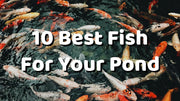
A fish-less pond is like a stage without actors—pretty yet missing the spark that holds an audience. Shimmering bodies lure children to scatter food, trim mosquito numbers, and splash the water with colors no lilies can equal. Stock thoughtfully, though, or that dream pond will slide into a murky, oxygen-starved mess. This guide shows you how to choose the right species, gear, and feeding routine so every walk around the edge feels like a fresh discovery.
Why Introduce Fish to Your Pond?
- Natural pest patrol – Goldfish inhale mosquito larvae; koi scrape string algae off rocks.
- Living motion – Flashing fins animate the water and draw every eye.
- Hands-on learning – Water tests and growth tracking turn backyard time into ecology lessons.
- Nutrient balance – In sensible numbers, fish waste fuels microbes that feed your plants, closing the loop.

Factors to Consider Before Choosing Pond Fish
- Climate tolerance. Can the species overwinter under ice? Will it cope with summer heat spikes?
- Mature size. Those two-inch babies may hit two feet within three summers.
- Temperament. Some fish nip fins or uproot lilies, others school peacefully.
- Filtration capacity. More fish = more waste. Poposoap's solar-powered pond filters, fountains, and aerators make it easier to keep oxygen up and ammonia down without running extension cords across the yard.
- Local regulations. A few states restrict grass carp or non-native catfish—check first.

Top 10 Good Pond Fish (Small to Large Ponds)
- Comet Goldfish — Tough, budget-friendly, and blazing in orange or white. Perfect first fish for patio tubs or ponds of 200 gallons and up.
- Shubunkin Goldfish — Calico bodies splashed with sky-blue, slimmer than koi yet just as eye-catching.
- Sarasa Comet — Snow-white base dotted with scarlet, a striking contrast against dark liners.
- Fantail Goldfish — Short, twin-tailed, and docile; keep water below 80 °F to prevent swim-bladder trouble.
- Mosquitofish — Tiny live-bearers that devour insect larvae; ideal for wildlife or rain-catch ponds under 100 gallons.
- Rosy Red Minnows — Pink-hued, cold-hardy “dither” fish that coax shy tank-mates into view.
- Golden Orfe — Fast, surface-cruising schoolers that streak silver-gold; need 500 gallons + and vigorous aeration.
- Koi Carp — The classic showpiece; demand 1,000 + gallons, robust bio-filtration, and constant oxygenation.
- Channel Catfish (dwarf strains) Bottom cleaners that hoover leftovers; stock lightly so they don’t outgrow goldfish.
- Sterlet Sturgeon — For deep, cool ponds (≥5 ft). Prehistoric elegance, but only in pristine, well-oxygenated, flowing water.

How Many Fish Can You Keep?
A safe rule for mixed goldfish ponds is 1 inch of fish body per 10 gallons; for koi, aim for 1 inch per 20 gallons once they mature. Use Poposoap’s online Pond Volume Calculator to nail your true gallon figure before you buy that extra bag of comets—your pump, not your eyes, should decide stocking density. Good planning prevents cloudy water and keeps oxygen comfortable even on scorching August afternoons.
Essential Pond Equipment for Healthy Fish
- Mechanical + bio filtration. Foam captures mulm; ceramic rings host nitrifying bacteria. Poposoap’s modular solar filter boxes start at 80 GPH for patio barrels and scale to 680 GPH systems for half-acre koi sanctuaries.
- Aeration. Floating solar fountains push oxygen across the surface while adding a dramatic plume—cooling water by evaporation and circulating layers.
- Water movement. Waterfall kits or stream pumps return filtered water high in the air column, stripping CO₂ and raising O₂ simultaneously.
- Lighting. Low-voltage or solar pond lights extend viewing hours and let you monitor fish behavior at night without netting them out.
Feeding Pond Fish: Tips for Healthy Diets
- Prioritize quality – In warm weather use high-protein floating pellets; when water dips below 55 °F (13 °C), switch to wheat-germ formulas.
- Mind the portions – Offer only what the fish finish in three minutes; leftovers become fertilizer for algae.
- Adapt to the seasons – As water cools to 50 °F (10 °C), koi digest more slowly: feed every other day—or pause feeding altogether.
- Choose smart supplements – Orange wedges (vitamin C), shelled peas (fibre), and the odd earthworm mimic natural forage.
- Watch while they eat – Lethargy, flashing, or clamped fins at feeding time signal health trouble early.
Building a Pond That’s Safe for Fish and Fun for You
Selecting the right species is a blend of biology and artistry. Begin with hardy fish in smaller basins; add koi or sturgeon only when depth and filtration can handle them. With dependable gear—solar pumps, floating aerators, and all-in-one filter kits—crystal-clear water becomes almost automatic, letting you simply enjoy the flashing fins that drew you outside in the first place. Plan wisely, feed well, and your backyard pond will reward you for years with color, calm, and that quiet thrill each time a fish breaks the surface.







